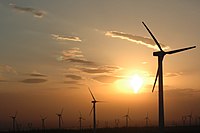
Photo from wikipedia
Abstract At present, vigorously developing wind power, photovoltaic and other renewable energy has become one of the effective ways to deal with carbon dioxide emissions and energy supply and demand… Click to show full abstract
Abstract At present, vigorously developing wind power, photovoltaic and other renewable energy has become one of the effective ways to deal with carbon dioxide emissions and energy supply and demand gap. Bringing renewable energy into the optimal configuration of power supply structure and reducing carbon emissions at the root will help promote the construction of clean, low-carbon, safe and efficient modern energy system. Therefore, starting from the theory of low-carbon economy, based on the traditional power planning model, this paper considers various uncertainties, introduces social welfare theory, and proposes the optimization scheme of thermal-solar-wind power system. The model is then applied to Southern Xinjiang supporting power project to study the investment behavior of low-carbon power, and the optimal low-carbon power decision-making behavior considering social benefits based on welfare is obtained. The results show that the proposed optimal configuration scheme of hybrid power can achieve the equilibrium between economic and social benefits, improve energy utilization efficiency and provide decision-making reference for policy makers.
Journal Title: Energy
Year Published: 2021
Link to full text (if available)
Share on Social Media: Sign Up to like & get
recommendations!